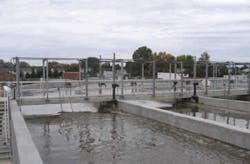The city of Elkton, Md., located near the head of the Chesapeake Bay, was recently required to meet new stringent wastewater effluent discharge regulations to protect aquatic life in the bay. The city’s wastewater treatment plant was using fine bubble air diffusers, which did not provide consistent nitrification and sufficient denitrification to meet the new requirements.
Finding a Solution
The city chose the Orbal biological nutrient removal (BNR) system from Evoqua Water Technologies. A suspended growth activated sludge process, the system is designed for BNR and energy efficiency. The activated sludge system consists of a series of concentric oxidation ditch channels and has the advantage of operating as a tanks-in-series system. This provides a higher overall kinetic reaction rate for the system, which allows treatment at higher organic loadings, reducing the size of the basins and lowering construction costs.
To solve the variability of treatment conditions caused by diurnal flow and load changes, the new wastewater treatment system design incorporated the SmartBNR electrical control system. Screened and de-gritted wastewater is directed to the outer channel of the basin where it is mixed with RAS returned from the clarifiers to form the system’s mixed liquor. The combined mixed liquor will pass progressively through the Orbal system’s channels before passing on to the final clarifiers.
System Anatomy
The outer channel is operated as an aerated anoxic reactor with dissolved oxygen (DO) levels near 0 mg/L. Simultaneous nitrification/denitrification and phosphorus release occurs in this zone. Oxidation/reduction potential (ORP) is used to monitor the condition of the outer channel.
The middle channel is a transition zone between the outer anoxic channel and the inner aerobic channel. Its condition may vary depending on the load coming into the plant. The inner channel is maintained in an aerobic state with DO levels at or above 2 mg/L. This supports the final nitrification required to complete treatment.
Each channel is physically separated so the environment within each channel can be controlled precisely to produce consistent treatment results. The SmartBNR PLC-based control system measures the ORP and DO conditions within each treatment zone in the system.
The Orbal basin at Elkton was designed with a 16-day solids retention time to ensure nitrification during cold weather. Other design parameters are a mixed liquor suspended solids (MLSS) of 4,000 mg/L and an organic loading rate of 16 lb of biological oxygen demand per day per 1,000 ft³.
For enhanced denitrification, an internal recycle wall pump with a maximum capacity of 12.8 million gal per day was included in the design to recycle nitrates in the nitrified MLSS from the inner channel to the anoxic outer channel. A second anoxic zone, followed by a re-aeration zone downstream of the basin, was included in the design to achieve greater than 95% total nitrogen removal.
The second anoxic zone was designed to have carbon provided by endogenous respiration. This allows for maximum denitrification without the need for supplemental carbon, resulting in additional daily operational cost savings.
Seeing Results
Commissioned in December 2008, the Elkton Orbal system is producing outstanding effluent quality. The operations staff has been able to optimize energy usage to reduce power consumption by approximately 40% more than that of the old system.



